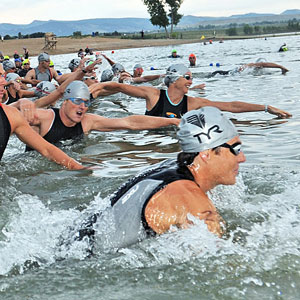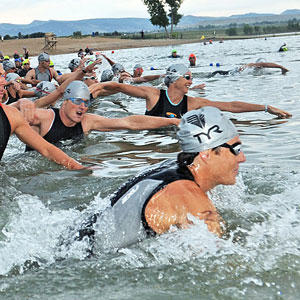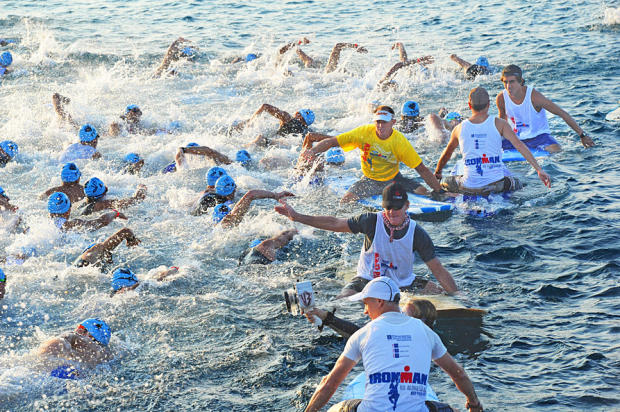Splitting The Field In Chattanooga

Before the race has even begun, the 2017 Ironman 70.3 World Championship in Chattanooga, TN is already a watershed moment in the history of Ironman racing. For the first time, men and women will compete on different days. Totally separate races have long been a fixture on the draft-legal ITU elite circuit, but never before has Ironman split the field at a world championship race.
This move represents the most significant acknowledgement to date of the influence of male athletes on the races of female competitors, both professional and age-group. It's also the latest in a long line of steps that has changed the fundamental nature of the sport from what was once truly a mass start event – pros and age-groupers, men and women.
As fields have grown, and the sport has become deeper in the level of competition, it became clear that the mass start approach was not sustainable. As recently (or as long ago) as fourteen years ago (2003) in Kona, all competitors started together; the pros got a brief head start of about ten seconds on the rest of the field. But there were also 1,605 competitors in 2002, versus 2,316 in 2016. And, crucially, the first competitor to finish over 10 hours in 2002 was the 196th athlete, whereas in 2016, you didn't cross the 10 hours barrier until the 453rd competitor (though it was arguably a faster year overall).
[Author note: I use 2002 as the reference even though 2003 was the last year of the "everyone together" mass-start because the results on ironman.com are formatted correctly for 2002 whereas they are not for 2003.]
There aren't just more people in Kona, there are more fast people in Kona.
The first significant change to the swim start was the clear separation of the professional and age-group fields by 15 minutes in 2004. Three more significant changes to the start have been made since the introduction of the KPR (Kona Points Ranking, the system by which professional athletes qualify) in 2012, 2014, and 2015. There is now virtually no room to further modify the start by making it earlier for professionals. The sun will rise at 6:18AM in Kailua-Kona, HI on October 14, 2017. Water safety is already concerned about the darkness when the pro men enter the water. And as a professional athlete, you can barely see anything when you first get in the water to warm-up.
[Author note: Ironman's media services team was extremely helpful in putting together the following timeline outlining the substantive changes to the swim start in Kona. It would have been impossible to document these changes as precisely as I have here without their help.]
2004. Split Professional & Age Group fields
- Professionals (male & female): 6:45AM
- Age-group (male & female): 7:00AM
2010. More time added between Professional Start & Age Group starts
- 6:30 am – Professional Start
- 7:00 am – Age Group Start
2012. Split the Pro Men & Pro Women starts
- 6:30 am Pro Men
- 6:35 am Pro Women
- 7:00 am Age Groupers
2014. First time Age Group athletes had two separate starts
- 6:25 am Pro Men
- 6:30 am Pro Women
- 6:50 am Age Group Men
- 7:00 am Age Group Women
2015. More time added between Pro Women & Age Group Men starts
- 6:25 am Pro Men
- 6:30 am Pro Women
- 6:55 am Age Group Men
- 7:10 am Age Group Women
Increasingly over the past several years – most notably since the KPR was instituted in 2010 for the 2011 edition of the race in Kona and the 70.3 World Championship, the issue of male competitors influencing the races of the female pros has been raised frequently and vociferously.
If there was not a sufficient buffer between the pro men and pro women, the faster pro women swimmers could easily get caught up with the slower pro men, enjoying the legal benefit of the 12m (and prior 10m) draft zone as well as the psychological benefit of pacing from a group of athletes that were almost certainly faster than their competitors.
On the flip side, if pro women did not have a sufficient buffer to the age-group athletes, fast age-group men would easily catch up to the slower pro women swimmers, which provided an even more significant drafting benefit given that the packs of fast age-group men were almost certainly larger than the packs of slow pro men.
[N.B: This was further complicated by a now-eliminated discrepancy in the draft rules – age-groupers were restricted to only 7m front-wheel-to-front-wheel, while pros were spaced at 10m. This allowed age-group men to slot in between pro women who were legally spaced, which put the female pros in a position where a drafting penalty was a real possibility. All competitors were moved to a 12m front-wheel-to-front-wheel draft zone in 2016. Current 2017 Ironman Competition Rules can be found here.]
There have been several examples of women whose races were irrevocably altered by such penalties, a tragedy at the championship level. The issue of slotting-in was eliminated with a universal shift to 12m for all competitors, but the issues of the draft and psychological pacing benefit remans, especially right out of the swim, where large packs within the age-group field can make enforcement an impossibility. This is especially true at the world championship level, where the depth of competition makes this an almost entirely intractable problem.
In Kona, for example, over 1,000 athletes flow through transition between about 1:00 and 1:10 (depending on the currents and how fast/slow the swim is in general), simply because almost everyone in Kona is a very good swimmer (and biker and runner).
Wave starts, which break up the field by age, and rolling starts, which break up the field by swim-speed, each can help. At the 70.3 World Championship, Ironman is using both wave starts and rolling starts within each wave to further spread out the field. This approach has always been more functional for 70.3 races, simply because the total time of the race is not an issue, unlike full-distance Ironman races with their 17hr cutoff.
But all of this manipulation still inevitably mixed women and men, and there's no denying that within both the professional and the age-group ranks, men were influencing women's races. In standalone running races, Paula Radcliffe was credited two world records for the marathon – one for her performance in a "mixed" field and another for a performance only within a female field. If the impact of male competitors is significant enough for the IAAF to acknowledge two different marks in the marathon, it's exponentially higher in triathlon.
The only real solution would be to totally separate the competitors. Ironman was able to do this to a certain extent quite easily with professionals, simply by making certain races "women only" and certain races "men only." But if they acknowledged it was an issue for the professionals, how could they not similarly acknowledge that this was an issue for age-groupers? Given Andrew Messick's (CEO of Ironman) at-times unpopular stance that Ironman should be equally fair (and equally unfair) to all competitors (male and female, pro and age-group), at some point, all of the women were going to need to be given their own race. The 70.3 World Championships in Chattanooga is the first such race.
But this introduces all sorts of additional challenges. Roads must be closed for two days. Volunteers need to work two days – or twice as many volunteers are needed. These are massive obstacles. That Ironman was able to pull this off in Chattanooga is remarkable. And I expect that the operations team is interested to see how well it works this upcoming weekend. And what sort of feedback emanates from the local community in the days and weeks afterward.
Success would likely represent something of a mixed blessing. In the event that this is a huge success, the demand for split fields at other races will grow. In particular, a split field in Kona seems the next logical step, but also a seemingly insurmountable hurdle. Two days of completely shutting down The Big Island. Two days of exhausting work in the heat and humidity for volunteer crews. I credit Ironman immensely for trying this in Chattanooga, but I also wonder what sort of pandora's box they may be opening.
In this way, Ironman's own actions here are truly remarkable. It's a bold admission of problems that have plagued races – especially championship ones where the fields are tighter and the stakes are higher. And it is also a totally credible and legitimate solution to those problems. But having now acknowledged these issues, it seems likely that Ironman must confront them beyond this weekend's races. Chattanooga represents a strong and bold step in this process, but it also inevitably leaves a huge question looming – "What's next?"




